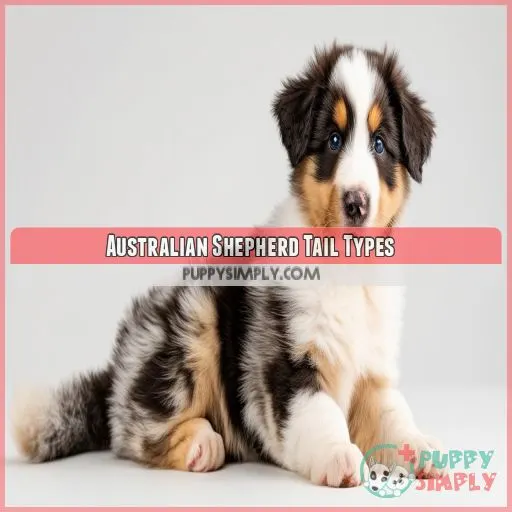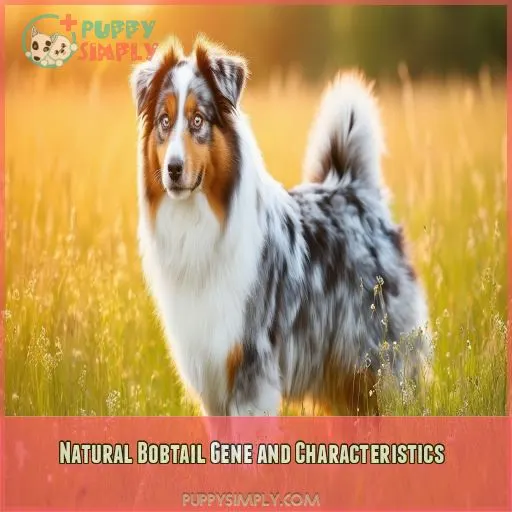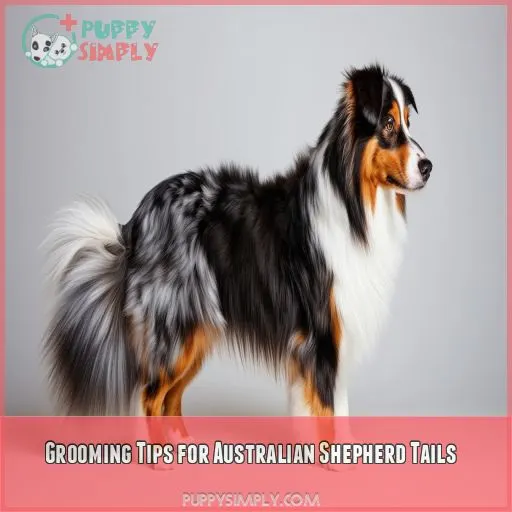This site is supported by our readers. We may earn a commission, at no cost to you, if you purchase through links.

This guide is here to help you navigate the ins and outs of this breed’s unique tail features, from health and care considerations to the impact of tail docking.
You’ll also discover the ethical dimensions and learn how to find responsible breeders who respect the natural beauty of this loyal companion.
Table Of Contents
- Key Takeaways
- Australian Shepherd Tail Types
- Reasons for Docking Tails
- Ethical Considerations in Tail Docking
- Impact of Tail Docking on Australian Shepherds
- Natural Bobtail Gene and Characteristics
- Health Risks Linked to Tail Docking
- Finding Responsible Breeders
- Behavioral Insights: Tail Wagging and Communication
- Tail Health: Common Problems and Care
- Grooming Tips for Australian Shepherd Tails
- Frequently Asked Questions (FAQs)
- Do Australian Shepherds have bobtails?
- How long are Australian Shepherd tails?
- How many types of Australian Shepherd tails are there?
- Do we know if Australian Shepherds have a ‘correct’ tail?
- Do some Australian Shepherds not have tails?
- Do breeders dock Aussie tails?
- Why are Australian Shepherds tails docked?
- Are toy Australian Shepherds born with tails?
- What are the pros and cons of tail docking?
- How common is tail docking today?
- Are there any alternatives to tail docking?
- How does tail docking impact a dogs health?
- What are the signs of tail-docking related issues?
- Conclusion
Key Takeaways
- The natural bobtail gene in Australian Shepherds is an incomplete dominant trait, resulting in a range of tail lengths, from short bobtails to long, flowing tails.
- Tail docking is a painful and unnecessary procedure that causes trauma, infection, and potential nerve damage. It is now banned in many countries due to ethical concerns and the priority given to canine welfare.
- Ethical breeding practices are crucial when considering an Australian Shepherd puppy. Reputable breeders prioritize the dog’s health, temperament, and genetic diversity, ensuring the preservation of the breed’s unique characteristics.
- The tail of an Australian Shepherd serves as a tool for emotional expression and social interaction, enhancing their balance and agility, and contributing to their overall health and well-being.
Australian Shepherd Tail Types
Regarding Australian Shepherd tail types, there’s much more assortment than is apparent. You may be accustomed to the iconic image of the breed sporting a short, docked tail, but there’s more to the narrative. Natural Aussie tails can vary from a quarter length to long and flowing, reaching up to 15 inches. Yes, you heard that correctly!
The natural bobtail gene is an incomplete dominant mutation, and it only takes one copy of the gene for a puppy to have a bobtail. This implies that even within the same litter, you can anticipate to see tail length variations. It’s like nature’s way of keeping things interesting!
But why do some Aussies have docked tails? Well, it’s primarily due to tradition and custom among breeders, although there are also aesthetic preferences and breed standards at play. However, we’ll save that discussion for another time. For now, let’s just appreciate the beauty and functionality of those natural Aussie tails!
Reasons for Docking Tails
While docking tails was once a customary practice for working dogs in harsh environments, it’s now considered an unnecessary and painful procedure that can cause trauma and infection. With ethical concerns and potential health risks also arising from the practice, it’s important to weigh the benefits of leaving tails intact, including enhanced balance, emotional expression, and breed diversity.
Pain and Trauma
The practice of tail docking involves cutting off a portion of a dog’s tail, and it’s often done to Australian Shepherds. This procedure is typically carried out on puppies, and it can be extremely painful for them, even with anesthesia or sedation.
Here are some key points to contemplate regarding the pain and trauma associated with tail docking:
- Newborn puppies experience excruciating pain during the procedure.
- The intense sensation can lead to immediate and long-lasting consequences.
- Nerve damage and infection are possible risks.
- Pain management and anesthesia options are important contemplations for responsible breeders.
Ethical Concerns
There are a number of ethical concerns surrounding the practice of tail docking, with many people opposed to the procedure. The main ethical argument against tail docking is that it’s a painful and unnecessary modification that causes suffering to the dog.
The American Veterinary Medical Association, along with many veterinarians, opposes non-medical tail docking. Additionally, leaving tails intact is becoming increasingly accepted, and many countries have restrictions on the practice.
Health Risks
Health risks associated with tail docking include:
- Nerve damage from severed nerves
- Infection prevention from open wounds
- Pain management and chronic pain, which can lead to mobility limitations
Ethical Considerations in Tail Docking
Regarding ethical breeding practices, the puppies’ pain and welfare must hold utmost importance. In contemporary times, the awareness of unnecessary pain and potential health risks associated with tail docking has grown, prompting a shift towards ethical breeding practices that prioritize canine well-being.
Ethical Breeding Practices
Ethical breeding practices are paramount when considering an Australian Shepherd puppy. Reputable breeders prioritize the dog’s health and temperament, ensuring genetic variability and conducting temperament testing to preserve the unique characteristics of the breed.
| Consideration | Practice |
|---|---|
| Genetic Variability | Breeders should aim to maintain genetic diversity within the breed, avoiding inbreeding to prevent health issues and promote canine individuality. |
| Temperament Testing | Testing helps preserve the desirable temperament traits of Australian Shepherds, ensuring your puppy grows into a well-adjusted adult dog. |
Adopting an Australian Shepherd from a rescue organization or ethical breeder who leaves tails intact is a responsible choice that contributes to the overall health and well-being of this beloved breed.
Pain and Welfare
Tail docking is a painful procedure that causes unnecessary suffering to your furry friend. Here are some key considerations regarding pain and welfare in the context of tail docking:
- Pain Management: Newborn puppies experience excruciating pain during tail docking, despite claims that they can’t feel pain at that age.
- Ethical Practices: Leaving tails intact is gaining acceptance, and many breeders support this due to ethical concerns.
- Health Benefits: Intact tails contribute to the dog’s overall health and well-being, enhancing balance and agility.
- Breed Standards: Keeping tails intact can improve compliance with breed standards, as tails are a natural feature of the breed.
- Aesthetic Preferences: While some prefer the appearance of docked tails, intact tails are considered a rare and desirable feature by many.
Modern Relevance
Ethical Considerations in Tail Docking
Today, the practice of tail docking is being questioned and re-evaluated. The pain and welfare concerns associated with the procedure have led to a growing acceptance of leaving tails intact. This shift in perspective is reflected in the stance of many breeders and countries that now prioritize the health and well-being of Australian Shepherds.
| Topic | Description |
|---|---|
| Breed Standards | Intact tails contribute to better compliance with breed standards, enhancing the natural beauty and functionality of the breed. |
| Tail Function | Tails play a crucial role in a dog’s balance, agility, and emotional expression, impacting their overall health and performance. |
| Ethics in Breeding | Tail docking is an unnecessary surgical procedure that causes pain and potential health risks. Ethical breeders prioritize the dog’s health and oppose non-medical docking. |
Impact of Tail Docking on Australian Shepherds
Now that we’ve explored the ethical considerations surrounding tail docking, let’s investigate the impact this practice has on Australian Shepherds.
When it comes to the impact of tail docking on Australian Shepherds, there are several factors to take into account, including:
- Traditions and Appearance: Tail docking has been a long-standing tradition among breeders, often done to conform to breed standards and aesthetic preferences. However, leaving tails intact is becoming more accepted, and many people now seek out Australian Shepherds with their natural, flowing tails.
- Pain and Welfare: Newborn puppies experience excruciating pain during the docking process, which can have immediate and long-lasting consequences. It’s essential to prioritize the puppy’s well-being and spare them from unnecessary suffering.
- Ethics and Health: Docking tails involves severing nerves and creates an open wound, posing health risks such as nerve damage and infection. It’s an invasive surgical procedure that can impact the dog’s overall health and well-being.
- Function and Expression: Tails play a crucial role in a dog’s balance and emotional expression. By keeping tails intact, you preserve their functional appendages and enhance their natural abilities.
- Breed Diversity and Standards: Encouraging diversity within the breed, leaving tails intact can also contribute to better compliance with breed standards.
Natural Bobtail Gene and Characteristics
The natural bobtail gene in Australian Shepherds is an incomplete dominant mutation, resulting in the breed’s characteristic short tail. Curiously, puppies only need to inherit one copy of this gene to exhibit the bobtail trait. This gene expression leads to a range of tail lengths, from a quarter length to longer variations.
| Tail Type | Length Description | Prevalence |
|---|---|---|
| Natural Bobtail | Around 1 in 5 Aussies | |
| Docked Tail | Typically 4 inches or less | |
| Long Tail | Flowing tails reaching up to 15 inches |
Natural bobtails are quite common among Aussies, with approximately one in five dogs possessing this unique feature. In contrast, docked tails are intentionally shortened, often for aesthetic or traditional reasons, resulting in a much shorter length. On the other hand, long-tailed Aussies showcase elegant, flowing tails that can reach an impressive length, adding to the overall beauty of the breed.
Health Risks Linked to Tail Docking
Tail docking can lead to several health complications for your Aussie, including nerve damage from severed nerves and increased risk of infection from the open wound. It’s important to prioritize infection prevention and proper pain management for your pup during the recovery process. Additionally, some dogs may experience chronic pain or limited mobility as a result of the procedure. The impact of tail docking on a dog’s performance in conformation events should also be considered.
These health risks underscore the importance of ethical breeding practices and responsible ownership. By understanding the potential consequences, you can make informed decisions that prioritize the well-being of your Australian Shepherd.
Finding Responsible Breeders
When selecting an Australian Shepherd breeder, it’s important to prioritize health and ethical considerations. Responsible breeders understand the potential negative effects of tail docking and support the preservation of natural tails. They acknowledge the importance of intact tails for the dog’s balance, agility, and emotional expression.
Opt for reputable breeders who prioritize the dog’s overall health and temperament. These breeders should be transparent about their practices and provide thorough health information for their puppies.
If you’re considering adoption, seek out rescue organizations that share similar values. Adopting an Australian Shepherd from a shelter or rescue group can be a rewarding experience, offering a second chance to a deserving dog.
Behavioral Insights: Tail Wagging and Communication
The tail of an Australian Shepherd is a powerful tool for emotional expression and social interaction. Their tails can express emotions and communicate with other dogs, enhancing their overall health and well-being.
Emotional Expression
Your Aussie’s tail is a beautiful and functional part of their body, enhancing their balance and agility. But did you know it’s also a powerful tool for emotional expression and communication with other dogs?
The diversity in tail length and flexibility allows Aussies to express a range of emotions, from excitement to contentment. A happy, relaxed dog might’ve a gently waving tail, while a more enthusiastic pup could have a tail that’s a blur of motion.
Social Interaction
Your Aussie’s tail is a key part of their social interaction.
It’s like their secret language for communicating with other dogs and you.
A slight wag or a full-on sweep of the tail can mean the difference between "I’m excited to see you" and "I’m feeling a bit nervous."
Tail Health: Common Problems and Care
Tail health is an important aspect of Australian Shepherd care. Common problems include tail chasing, biting, and hot spots, which can impact your dog’s posture and overall health.
Tail Chasing & Biting
Chasing and biting their tails can be a sign of underlying issues. It could be due to boredom, excess energy, or even anxiety. Make sure your Aussie has enough mental and physical stimulation through play, exercise, and training. If the behavior persists, consult a veterinarian or behaviorist to rule out any health or emotional problems.
Hot Spots
Hot spots are a common issue for Australian Shepherds, often caused by allergies or excessive licking. Here are some key points about hot spots and tail health:
- Hot spots are localized areas of inflammation and infection on the skin, typically appearing as red, swollen patches.
- They can be itchy and painful for your Aussie, and may require veterinary attention if left untreated.
- Regular tail cleanliness and hygiene are important to prevent hot spots and other tail infections.
- Monitor your Aussie’s tail wagging patterns for any unusual behavior that could indicate discomfort or irritation.
Posture and Health
Understanding the Link for Tail Care
Your Aussie’s tail posture can offer clues about their health and emotions. A healthy tail should be flexible and expressive, reflecting your dog’s mood and energy level. Here’s a table to help you interpret your Aussie’s tail language:
| Tail Posture | Possible Emotion | Tail Anatomy |
|---|---|---|
| High and upright | Alert, curious, excited | Spine straight, tail held high |
| Low and relaxed | Calm, content, relaxed | Spine curved, tail low |
| Wagging vigorously | Happy, playful, friendly | Spine and tail moving side to side |
| Tucked between legs | Fearful, anxious, submissive | Tail pulled in, close to body |
Grooming Tips for Australian Shepherd Tails
Grooming your Australian Shepherd’s tail is an important part of their overall care. Shaving your dog’s tail, managing shedding, and maintaining proper hygiene practices will all help keep your Aussie’s tail healthy and looking its best.
Shaving Your Shepherd’s Tail
Shaving your Australian Shepherd’s tail can be a tricky decision. While some owners report positive outcomes, others have experienced issues. Here are some key considerations:
- Trimming vs Shaving: Instead of a full shave, consider a trim. Trimming the fur under the tail, on the legs, and around the buttocks can help keep your dog cool without removing their protective coat.
- Texture Changes: If you do decide to shave, be aware that the regrown hair may have a different texture. It may not be as excellent as the original coat.
- Skin Issues: Shaving can cause skin problems and affect your dog’s ability to regulate body temperature.
- Caution with Scissors: When trimming the tail, use only the tips of the scissors to avoid accidentally nicking this delicate area.
Shedding and Maintenance
As an Australian Shepherd owner, you know that shedding is a natural process, but it can also be a challenge. Regular maintenance is key to keeping your Aussie’s tail healthy and your home fur-free. Here’s a table with some quick tips:
| Maintenance Tips | Recommendations |
|---|---|
| Brushing | Brush your Aussie’s tail 2-3 times a week to remove loose hair and prevent matting. |
| Bathing | Bathe your dog once a month or as needed, using a gentle shampoo to avoid drying out their skin. |
| Trimming | Trim the tail hair every 6-8 weeks to keep it neat and manageable, especially if your Aussie has a long tail. |
| Shedding Management | Invest in a good deshedding tool to reduce shedding and keep your Aussie’s tail coat healthy. |
| Environment | Create a comfortable environment with the right temperature and humidity to minimize shedding. |
Hygiene Practices
Maintaining proper hygiene for your Australian Shepherd’s tail is essential for their overall health and well-being. Here are some key practices to guarantee tail cleanliness and grooming:
- Regular Brushing: Brush your Aussie’s tail fur at least once a week to prevent matting and tangles. This helps distribute natural oils, keeping the tail coat healthy and shiny.
- Tail Baths: When bathing your Aussie, pay extra attention to the tail. Use a gentle, dog-safe shampoo to thoroughly clean the tail fur, ensuring you rinse all the soap out to avoid irritation.
- Tail Inspection: Regularly inspect your dog’s tail for any signs of irritation, hot spots, or parasites. This proactive approach can help identify potential issues early on, guaranteeing your Aussie’s tail stays healthy.
- Hygiene for Bobtails: If your Aussie has a natural bobtail, pay close attention to the base of the tail. This area can be prone to dirt and debris buildup, so regular cleaning and grooming are essential to maintaining tail hygiene.
Frequently Asked Questions (FAQs)
Do Australian Shepherds have bobtails?
Yes, Australian Shepherds can have natural bobtails due to an incomplete dominant gene. However, breeding for bobtails can result in health defects, and docking is now banned.
How long are Australian Shepherd tails?
The length of an Australian Shepherd’s tail varies. Natural bobtails can be 4 inches or less, but also much longer. About 47% of natural bobtails are a quarter-length or longer, and 10% are kinked.
How many types of Australian Shepherd tails are there?
There are two types of Australian Shepherd tails: bobbed and normal. Around 20% of Aussies have naturally bobbed tails, and the rest have normal tails, which can vary in length.
Do we know if Australian Shepherds have a ‘correct’ tail?
There is no ‘correct’ tail length for Australian Shepherds. Natural tails can vary from long to short, and bobbed tails are also common.
Do some Australian Shepherds not have tails?
You might see an Australian Shepherd with a docked tail or a natural bobtail. Some Aussies are even born without any tail at all!
Do breeders dock Aussie tails?
Yes, breeders dock Aussie tails. The decision to dock an Australian Shepherd’s tail should prioritize the dog’s welfare, considering both practical and ethical concerns.
Why are Australian Shepherds tails docked?
Australian Shepherds’ tails are docked for a variety of reasons, including tradition, identification, aesthetics, and functionality. Docking is also done to prevent tail injuries and infections.
Are toy Australian Shepherds born with tails?
Yes, toy Australian Shepherds are sometimes born with tails. However, they aren’t officially recognised by any kennel clubs or breed groups.
What are the pros and cons of tail docking?
Pros: aesthetics, injury prevention, breed standard compliance. Cons: nerve damage, infection, pain, impaired performance, ethical concerns, and health risks.
How common is tail docking today?
Tail docking is still practiced today, although it’s becoming less common as more countries ban the procedure. It’s unrestricted in some places, but banned in others.
Are there any alternatives to tail docking?
You might consider choosing a breed with shorter tails or opting for selective breeding toward a tail of the desired length. Other alternatives include moving your flock to exposed environments during seasons with a high risk of fly attacks or ensuring you have a well-prepared farm with preventive measures in place.
How does tail docking impact a dogs health?
Tail docking can cause acute and chronic pain, infection, impaired locomotion, communication defects, and underdeveloped pelvic musculature. It also deprives dogs of a form of expression.
What are the signs of tail-docking related issues?
Think of your dog’s tail as a window to their soul and well-being. Red flags to watch for include tail chasing, biting, or a "limber tail." These could indicate underlying issues related to docking. Keep an eye on your pup’s tail-wagging patterns for any unusual behavior.
Conclusion
Like a shepherd guiding their flock, this article has navigated you through the intricacies of Australian Shepherds’ tails, from the impact of docking to the ethical dimensions of breeding practices.
You’ve explored health risks, natural tail characteristics, and the importance of responsible breeding.
Now, you’re equipped with insights on tail health, communication, and grooming.
With this knowledge, you can appreciate the unbounded energy of an Australian Shepherd puppy with its tail intact and make informed decisions regarding their care and well-being.
















